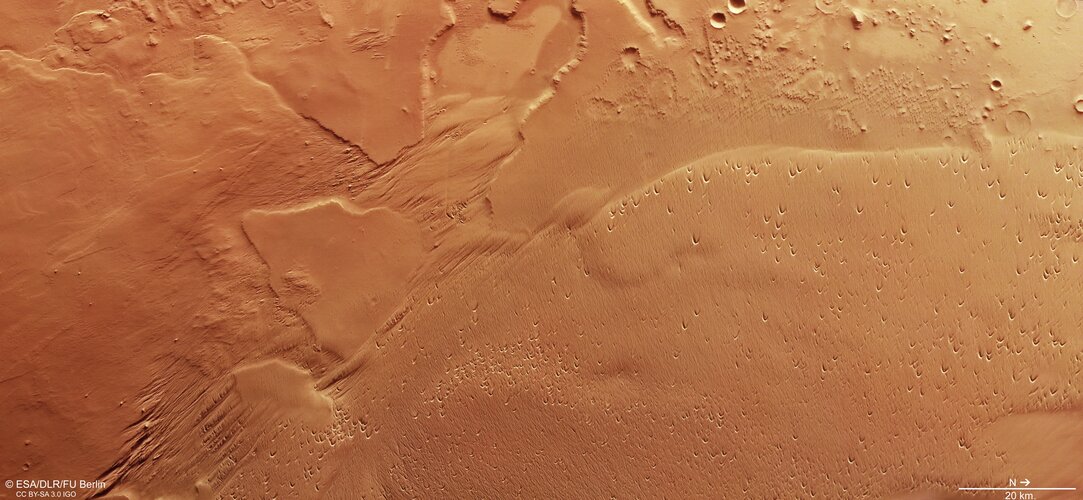Lynk reveals mobile network contracts
Wednesday, 23 February 2022 10:00
Lynk Global announced contracts Feb. 23 with seven mobile network operators serving Pacific and Caribbean Island nations.
The post Lynk reveals mobile network contracts appeared first on SpaceNews.
Caution! Martian wind at work
Wednesday, 23 February 2022 10:00
This image from ESA’s Mars Express shows part of possibly the largest single source of dust on Mars: a wind-sculpted feature known as the Medusae Fossae Formation, or MFF.
How Software Steers the Return to the Moon
Wednesday, 23 February 2022 09:07
The 1960s ushered in an era of human space exploration that has never been equaled
The post How Software Steers the Return to the Moon appeared first on SpaceNews.
SpaceX to launch SpaceLogistics Mission Extension Pod for Optus satellite
Wednesday, 23 February 2022 04:57 Northrop Grumman Corporation's SpaceLogistics has announced a launch agreement for its Mission Robotic Vehicle (MRV) spacecraft, and the sale of its first Mission Extension Pod (MEP).
Under the launch agreement, SpaceX will provide launch services for a planned spring 2024 launch of the MRV and several MEPs. Optus, Australia's largest satellite owner and operator, recently completed a purchase
Northrop Grumman Corporation's SpaceLogistics has announced a launch agreement for its Mission Robotic Vehicle (MRV) spacecraft, and the sale of its first Mission Extension Pod (MEP).
Under the launch agreement, SpaceX will provide launch services for a planned spring 2024 launch of the MRV and several MEPs. Optus, Australia's largest satellite owner and operator, recently completed a purchase Scottish Space Sector Charts Path to a Sustainable Future
Wednesday, 23 February 2022 04:57 A specialist working group of the industry-led group Space Scotland is contributing to the development of a sustainable space sector by collaborating on a roadmap that will focus on environmental issues in one of Scotland's fastest-growing industries. On behalf of the Space Scotland's Environmental Task Force, AstroAgency and Optimat will work with Scottish companies, international collaborators
A specialist working group of the industry-led group Space Scotland is contributing to the development of a sustainable space sector by collaborating on a roadmap that will focus on environmental issues in one of Scotland's fastest-growing industries. On behalf of the Space Scotland's Environmental Task Force, AstroAgency and Optimat will work with Scottish companies, international collaborators Whitepaper highlights ground segment's critical role in satellite connectivity
Wednesday, 23 February 2022 04:57 The satellite industry is set for unprecedented transformation, with the impact of cloud-based systems, the introduction of next-generation NGSO broadband constellations, and convergence towards a unified 5G network architecture. However, ground segments will also have to play a pivotal role to allow the industry to fully embrace and benefit from these changes.
While satellites have embark
The satellite industry is set for unprecedented transformation, with the impact of cloud-based systems, the introduction of next-generation NGSO broadband constellations, and convergence towards a unified 5G network architecture. However, ground segments will also have to play a pivotal role to allow the industry to fully embrace and benefit from these changes.
While satellites have embark Monitoring Arctic permafrost with satellites, supercomputers, and deep learning
Wednesday, 23 February 2022 04:57 Permafrost - ground that has been permanently frozen for two or more years - makes up a large part of the Earth, around 15% of the Northern Hemisphere. Permafrost is important for our climate, containing large amounts of biomass stored as methane and carbon dioxide, making tundra soil a carbon sink. However, permafrost's innate characteristics and changing nature are not broadly understood.
Permafrost - ground that has been permanently frozen for two or more years - makes up a large part of the Earth, around 15% of the Northern Hemisphere. Permafrost is important for our climate, containing large amounts of biomass stored as methane and carbon dioxide, making tundra soil a carbon sink. However, permafrost's innate characteristics and changing nature are not broadly understood. The second-generation PRISMA Earth observation system gets underway
Wednesday, 23 February 2022 04:57 Thales Alenia Space, the joint venture between Thales (67%) and Leonardo (33%), has signed a contract with the Italian space agency (ASI) to conduct a feasibility study for the PRISMA Second Generation (PSG) hyperspectral Earth observation system. It will be leading a consortium that includes Leonardo, Telespazio (the joint venture between Leonardo (67%) and Thales (33%)), e- GEOS and SITAEL.
Thales Alenia Space, the joint venture between Thales (67%) and Leonardo (33%), has signed a contract with the Italian space agency (ASI) to conduct a feasibility study for the PRISMA Second Generation (PSG) hyperspectral Earth observation system. It will be leading a consortium that includes Leonardo, Telespazio (the joint venture between Leonardo (67%) and Thales (33%)), e- GEOS and SITAEL. Rocky Road offers plenty of tasty science bites during Sols 3391-3394
Wednesday, 23 February 2022 04:57 MSL planning was met with beautiful images of our path ahead, like this one. We ended up planning to look at many of these rocks with our science instruments before driving on. This is a busy plan, covering four sols due to the holiday on Monday. In order to keep things manageable, especially given that our uplink is early tonight, we are doing all of our activities on the last 3 sols of the pla
MSL planning was met with beautiful images of our path ahead, like this one. We ended up planning to look at many of these rocks with our science instruments before driving on. This is a busy plan, covering four sols due to the holiday on Monday. In order to keep things manageable, especially given that our uplink is early tonight, we are doing all of our activities on the last 3 sols of the pla Day of Discovery: 7 Earth-Size Planets
Wednesday, 23 February 2022 04:57 Newspapers around the world printed the discovery on their front pages: Astronomers had found that a red dwarf star called TRAPPIST-1 was home to a close-knit family of seven Earth-size planets. NASA announced the system Feb. 22, 2017.
Using telescopes on the ground and in space, scientists revealed one of the most unusual planetary systems yet found beyond our Sun and opened the tantalizi
Newspapers around the world printed the discovery on their front pages: Astronomers had found that a red dwarf star called TRAPPIST-1 was home to a close-knit family of seven Earth-size planets. NASA announced the system Feb. 22, 2017.
Using telescopes on the ground and in space, scientists revealed one of the most unusual planetary systems yet found beyond our Sun and opened the tantalizi The secret of Venus may be hidden in the heat of the night
Wednesday, 23 February 2022 04:57 Despite being close to Earth and having nearly the same size, Venus is another world. Underneath its thick mantle of acid sulfuric clouds, at the surface 460 degrees Celsius are the rule. This temperature is kept by the greenhouse effect of a virtually carbon dioxide only atmosphere. Seventy kilometres above, one has to withstand a perpetual wind storm, the product of the so called Venus superro
Despite being close to Earth and having nearly the same size, Venus is another world. Underneath its thick mantle of acid sulfuric clouds, at the surface 460 degrees Celsius are the rule. This temperature is kept by the greenhouse effect of a virtually carbon dioxide only atmosphere. Seventy kilometres above, one has to withstand a perpetual wind storm, the product of the so called Venus superro 'Tatooine-like' exoplanet spotted by ground-based telescope
Wednesday, 23 February 2022 04:57 A rare exoplanet which orbits around two stars at once has been detected using a ground-based telescope by a team led by the University of Birmingham.
The planet, called Kepler-16b, has so far only been seen using the Kepler space telescope. It orbits around two stars, with the two orbits also orbiting one another, forming a binary star system. Kepler-16b is located some 245 light years fr
A rare exoplanet which orbits around two stars at once has been detected using a ground-based telescope by a team led by the University of Birmingham.
The planet, called Kepler-16b, has so far only been seen using the Kepler space telescope. It orbits around two stars, with the two orbits also orbiting one another, forming a binary star system. Kepler-16b is located some 245 light years fr Galaxy collision creates 'space triangle' in new Hubble image
Wednesday, 23 February 2022 04:57 A spectacular head-on collision between two galaxies fueled the unusual triangular-shaped star-birthing frenzy, as captured in a new image from NASA's Hubble Space Telescope. The interacting galaxy duo is collectively called Arp 143. The pair contains the glittery, distorted, star-forming spiral galaxy NGC 2445 at right, along with its less flashy companion, NGC 2444 at left.
Astronomers s
A spectacular head-on collision between two galaxies fueled the unusual triangular-shaped star-birthing frenzy, as captured in a new image from NASA's Hubble Space Telescope. The interacting galaxy duo is collectively called Arp 143. The pair contains the glittery, distorted, star-forming spiral galaxy NGC 2445 at right, along with its less flashy companion, NGC 2444 at left.
Astronomers s What ingredients went into the galactic blender to create the Milky Way
Wednesday, 23 February 2022 04:57 Our galaxy is a giant 'smoothie' of blended stars and gas but a new study tells us where the components came from. In its early days, the Milky Way was like a giant smoothie, as if galaxies consisting of billions of stars, and an enormous amount of gas had been thrown together into a gigantic blender. But a new study picks apart this mixture by analysing individual stars to identify which origin
Our galaxy is a giant 'smoothie' of blended stars and gas but a new study tells us where the components came from. In its early days, the Milky Way was like a giant smoothie, as if galaxies consisting of billions of stars, and an enormous amount of gas had been thrown together into a gigantic blender. But a new study picks apart this mixture by analysing individual stars to identify which origin Virgin Galactic on schedule to start commercial human suborbital flights this year
Wednesday, 23 February 2022 02:10
Virgin Galactic executives said Feb. 22 that they remain on schedule to begin commercial human suborbital missions before the end of the year but acknowledged it will take several years for the company to become profitable.

